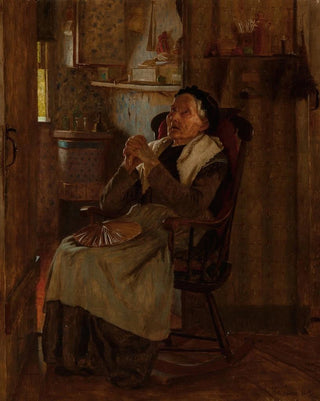Art print | C'était il y a longtemps - John George Brown


View from behind

Frame (optional)
In the vibrant universe of art, some artworks manage to capture the essence of a moment with such intensity that they transcend time. "It Was a Long Time Ago - John George Brown" is one of those creations that, through its delicate and emotive representation, transports us to a nostalgic past. This piece, emblematic of realism, evokes not only a scene from everyday life but also the buried memories that each of us carries within. Through Brown's keen eye, the viewer is invited to contemplate a bygone era, to feel the emotions of the characters, and to question the stories behind each gaze.
Style and uniqueness of the work
The uniqueness of "It Was a Long Time Ago" lies in how John George Brown manages to combine the simplicity of an ordinary scene with striking emotional depth. The artist uses a palette of soft, warm colors, creating an intimate atmosphere that envelops the viewer. The meticulous details, from facial expressions to delicate gestures, testify to a concern for realism that allows the work to vibrate with its own life. Brown knows how to play with light, making it dance across the faces of the characters, thus adding an almost tangible dimension to the scene. This ability to capture the moment, to freeze time while making it ephemeral, makes this work a true masterpiece of the genre.
The artist and his influence
John George Brown, born in 1831 in Newcastle, England, was a painter whose work marked his era through his commitment to depicting the lives of the working classes. Influenced by the masters of realism, he developed a unique style that combines technical precision with human sensitivity. His career, marked by success, testifies to the evolution of an artist passionate about the human condition and the world around him. Through his works, Brown gave a voice to those who, often, had none. His influence endures today, inspiring many contemporary artists to explore themes of memory, identity, and collective stories. By bringing scenes from the past back to life, he reminds us of the importance of our

Matte finish

View from behind

Frame (optional)
In the vibrant universe of art, some artworks manage to capture the essence of a moment with such intensity that they transcend time. "It Was a Long Time Ago - John George Brown" is one of those creations that, through its delicate and emotive representation, transports us to a nostalgic past. This piece, emblematic of realism, evokes not only a scene from everyday life but also the buried memories that each of us carries within. Through Brown's keen eye, the viewer is invited to contemplate a bygone era, to feel the emotions of the characters, and to question the stories behind each gaze.
Style and uniqueness of the work
The uniqueness of "It Was a Long Time Ago" lies in how John George Brown manages to combine the simplicity of an ordinary scene with striking emotional depth. The artist uses a palette of soft, warm colors, creating an intimate atmosphere that envelops the viewer. The meticulous details, from facial expressions to delicate gestures, testify to a concern for realism that allows the work to vibrate with its own life. Brown knows how to play with light, making it dance across the faces of the characters, thus adding an almost tangible dimension to the scene. This ability to capture the moment, to freeze time while making it ephemeral, makes this work a true masterpiece of the genre.
The artist and his influence
John George Brown, born in 1831 in Newcastle, England, was a painter whose work marked his era through his commitment to depicting the lives of the working classes. Influenced by the masters of realism, he developed a unique style that combines technical precision with human sensitivity. His career, marked by success, testifies to the evolution of an artist passionate about the human condition and the world around him. Through his works, Brown gave a voice to those who, often, had none. His influence endures today, inspiring many contemporary artists to explore themes of memory, identity, and collective stories. By bringing scenes from the past back to life, he reminds us of the importance of our






